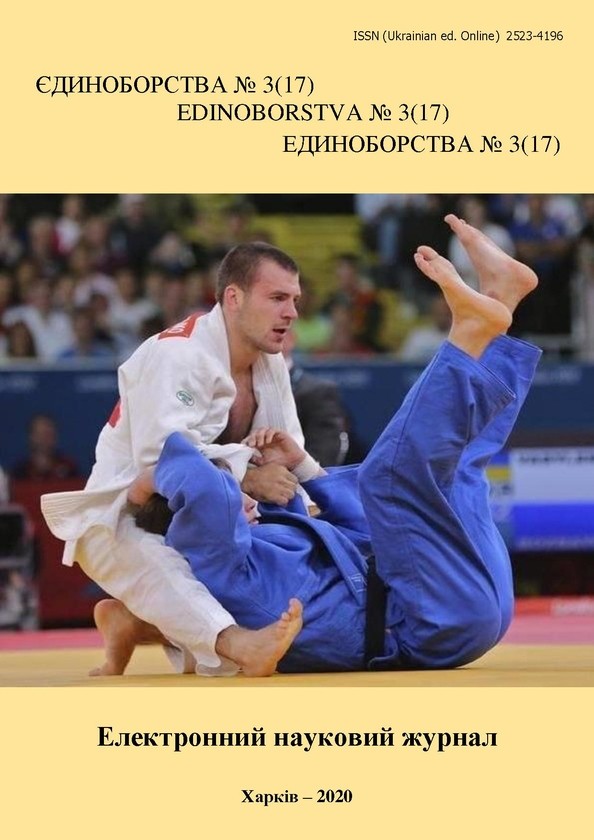Динаміка розвитку спритності дзюдоїстів на оздоровчо-спортивному етапі під впливом ігор з фітболами
DOI:
https://doi.org/10.15391/ed.2020-3.10Ключові слова:
спритність, дзюдо, оздоровчо-спортивний етап, розвиток, динаміка, ігри, фітболАнотація
Мета: дослідити динаміку розвитку спритності у дзюдоїстів 6-7 років під впливом ігор з фітболами. Матеріал і методи. В дослідженні прийняло участь 15 дзюдоїстів віком 6-7 років, які знаходились на оздоровчо-спортивному етапі. Дослідження проводилось на базі СК «Метеор» м. Дніпро. Для вирішення поставлених завдань застосовувалися наступні методи дослідження: теоретичний аналіз і узагальнення літературних джерел, педагогічне дослідження, педагогічне тестування, методи математичної статистики. Результати: заняття на оздоровчо-спортивному етапі проводились за діючою навчальною програмою з дзюдо для ДЮСШ. Особливістю проведення навчально-тренувальних занять було додаткове застосування ігор з використанням фітболів, спрямованих на розвиток спритності. Були запропоновані ігри «Фітбол крабів», «Юні сумоїсти» та «Відбери м’яч». Педагогічне дослідження проводилось на протязі 1-го року. Порівняння середніх показників отриманих результатів на початку та в кінці педагогічного дослідження показали статистично достовірну різницю у всіх тестах (<0,05). Так, у тесті «Човниковий біг, 3х10 м» результат покращився з 10,3 до 9,82 с., у тесті «Метання тенісного м’яча у ціль» з 2,31 до 3,22 точних спроб, у тесті «Фламінго» з 22, 10 до 24,85 с., у тесті «Три перекиди вперед» з 9, 96 до 9,55 с. Найкращий результат приросту спостерігається у тестах «Метання тенісного м’яча у ціль» (t=6,07; p<0,05) та «Фламінго» (t=4,19; p>0,05). Висновки. Здійснений підбір ігор з футболами, спрямованих на розвиток спритності дзюдоїстів 6-7 років. Запропоновані ігри дозволяють розвивати просторову орієнтацію, узгодженість рухів, взаємодію з предметами та іншими спортсменами під час ігор. Порівняння середніх показників отриманих результатів на початку та в кінці педагогічного дослідження показали статистично достовірну різницю у всіх тестах (<0,05). Найкращий результат приросту спостерігається у тестах «Метання тенісного м’яча у ціль» 39 %; «Фламінго» 13 %. У тестах «Човниковий біг, 3х10 м» приріст склав – 4,66 %, «Три перекиди вперед» - 4,12 %. Отримані результати динаміки розвитку спритності підтверджують ефективність запропонованих ігор з фітболами для дзюдоїстів 6-7 років, що покращує показники здатності до орієнтування у просторі та управління рухами по просторово-динамічним параметрам.
Посилання
Алексєєв А. Ф., Юхно Ю. О., Середа В. А., & Перета В. С. (2017). Навчальна програма для дитячо-юнацьких спортивних шкіл, спеціалізованих ДЮСШ олімпійського резерву, шкіл вищої спортивної майстерності та спеціалізованих навчальних закладів спортивного профілю (спортивні інтернати). Київ.
Ананченко, К. В., & Середа, В. В. (2008). Технічна підготовка юних дзюдоїстів на основі аналізу модельних характеристик. Teorìâ ta Metodika Fìzičnogo Vihovannâ, (8), 47-49.
Бернштейн, Н. А. (1991). О ловкости и ее развитии. Учебное пособие. Физкультураи спорт. Москва.
Бойченко, Н. В. (2007). Пути повышения эффективности тренировочного процесса в восточных единоборствах. Физическое воспитание студентов творческих специальностей, 2, 148-150.
Бойченко, Н. В., & Чоботько, М. А. (2019). Оптимізація навчання техніки дзюдо за допомогою вправ з фітболом. Єдиноборства, № 3 (13), 13-20.
Бойченко, Н. В., Станкевич, Б., & Дрозд, М. С. (2014). Контроль за станом підготовленості борця. Проблемы и перспективы развития спортивных игр и единоборств в высших учебных заведениях, 1, 14-17.
Ермаков, С. С., Тропин, Ю. Н., & Бойченко, Н. В. (2016). Специальная физическая подготовка квалифицированных борцов. Единоборства, 20-22.
Камаєв, О. І., Тропін, Ю. М., & Арнаут, В. Ю. (2019). Біомеханічний аналіз виконання технічних дій у спортивній боротьбі. Проблеми і перспективи розвитку спортивних ігор і єдиноборств у вищих навчальних закладах, 1, 32-35.
Платонов, В. Н. (2015). Система подготовки спортсменов в олимпийском спорте. Общая те- ория и ее практические приложения : учебник [для тренеров] : 2 кн. Олимп. лит., Киев.
Романенко, В. А. (2005). Диагностика двигательных способностей. Учебное пособие, ДонНУ, Донецк.
Филин, С. А. (2013). Методика двигательно-координационной подготовки юных самбистов на этапе начальной спортивной специализации. Вестник спортивной науки, (1), 17-22.
Чоботько, М. А. (2018). Особенности методики обучения дзюдоистов новичков. Проблемы и перспективы развития спортивных игр и единоборств в высших учебных заведениях. Том 1, 75-78.
Чоботько, М. А., Чертов, І. І., Бойченко, Н. В., Зантарая, Г. М., & Чоботько, І. І. (2019). Застосування вправ з футболом при навчанні техніці кидків в дзюдо. Єдиноборства, № 4 (14), 127-137.
Чоботько, М. А., Чоботько, І. І., & Бойченко, Н. В. (2020). Розвиток рівноваги за допомогою вправ з балансування на фітболах. Єдиноборства, № 1 (15), 78-88.













